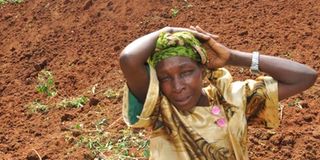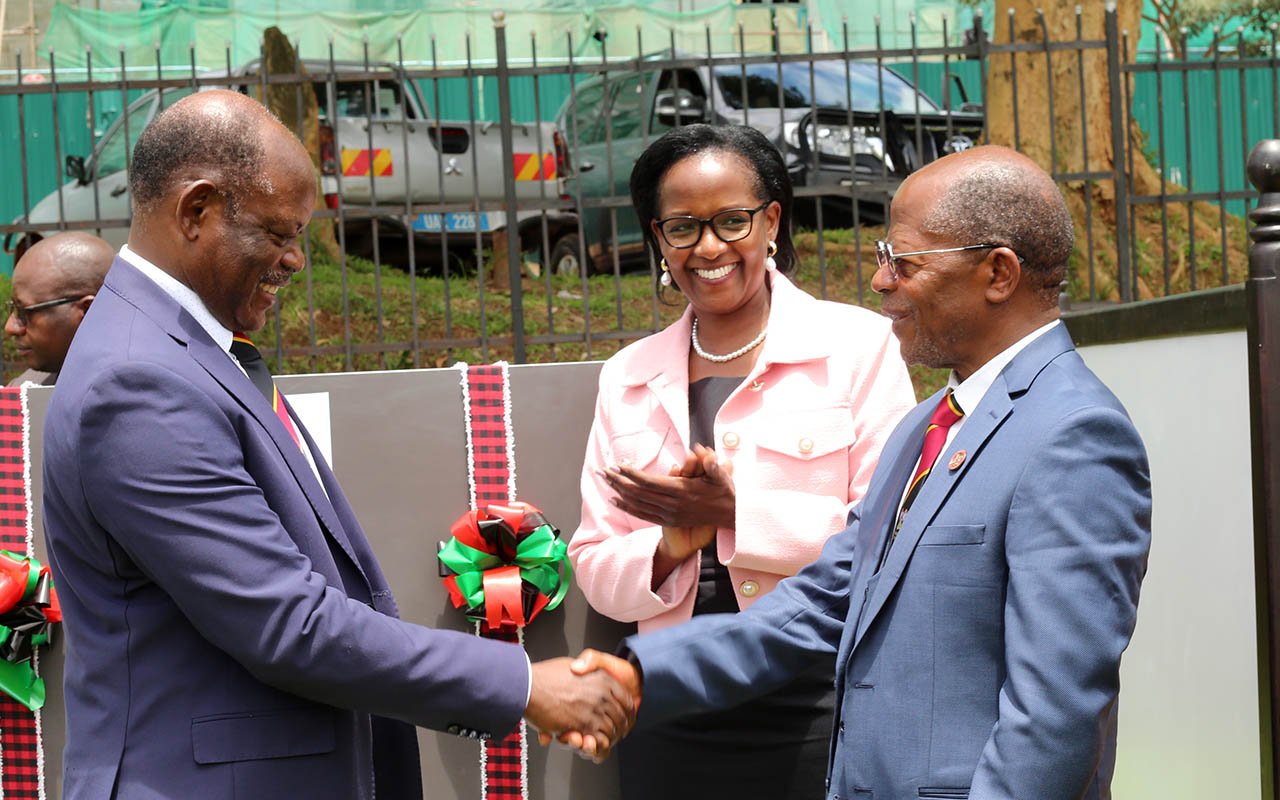Bududa mudslides: The disaster that keeps hitting

A woman cries for her four children she lost in last year’s mudslide. This year, although the death toll is not as high the number of people displaced is daunting as it falls in the thousands. FILE PHOTO
That tragedy strikes and catches a Disaster Preparedness ministry unprepared borders on the eccentric. Yet in Uganda, such colossal government and citizenry failure is commonplace.
Why? Because bureaucrats and local politicians speak in tongues: Trumpet populist notions in public and act the opposite in private with voters playing midwife.
As such, critics have mocked the line ministry as a “worse disaster” for the country, especially when the aged Prof Tarsis Kabwegyere, who spoke callously of disaster victims, was in charge.
The professor may have been recalled from the political cold, assigned a cabinet docket of General Duties in the Office of the Prime Minister after stubborn women activists rejected him outright at the Gender ministry, but Uganda’s nightmares of disaster mismanagement remain alive.
Perpetual unpreparedness
When a combination of mudslides and unprecedented hailstorms tormented Bududa District on August 10, killing a four-year-old baby, destroying homes and vast crop fields and displacing hundreds, the government did not even have emergency food relief in store for the victims.
Available portions had apparently been trucked up north to feed 6,000 persons displaced when River Unyama in Amuru District burst its banks.
In the east of the country, members of Bududa disaster management committee met under the stewardship of district chairman John Baptist Nambeshe, but without supporting resources, they could like every humanist only empathise.
But how did the country sleep-walk down this disaster path? Why, for instance, doesn’t the government build silos in every region and stock them with foodstuff — bought from farmers during plentiful harvest — so relief can reach disaster victims faster than when hauled from the capital, Kampala?
The blame has its legs in inaction, or often defective decisions, by both irresponsible citizens and a crop of wavering leaders eager to appease the led.
For instance, mudslide occurrence on the slopes of Mt Elgon dates back to the early 20th century, according to published works. Geologists had by 2002 recorded some 98 landslides in Manjiya (a sub-county in Bududa), according to their study published in the Elsevier journal.
In March 2010, mudslides buried an estimated 350 people alive in Nametsi parish of Bududa District. Without motorable roads and a bad terrain, even the heavy-earth moving equipment the UN airlifted from the Democratic Republic of Congo to dig up bodies from under the debris, failed.
And government decided to re-settle those at high-risk of another mudslide in the relatively flat Kiryadongo in Bunyoro sub-region. Differences in culture and unprincipled discouragement by elected leaders provoked resistance to the programme.
The government intervened and later some 600 households were relocated with a promise that each would be provided a house and two-and-a-half acres of arable land.
Ministry officials also said a vocational institute would be erected to re-absorb school dropouts into formal education to hone their vocational skills in a sub county without a public secondary school.
Plans go awry
As is the jinx with most state programmes, it emerged the scheme had been mismanaged: Ineligible people from non-mudslide-prone areas had been registered to benefit and bureaucrats inflated bills of quantity for 600 houses planned to be built for the genuinely displaced over three years. Telecom giant, MTN, and UN Habitat have added an extra 20 units.
With money problems at hand, State minister for Disaster Preparedness Musa Ecweru, says only 100 houses were constructed in the first year, and the shelter provision is expected to resume later this financial year. Dejected, some families left the settlement, complaining, among other things, of famine and shortage of land and opportunities for them in an alien hinterland. The masqueraders had fled before them after being identified.
By some accounts, individuals relocated from Bududa to Kiryandongo got bumper maize harvest in the first year, but many families sold including the crop fields to buyers from South Sudan.
When drought hit in 2011, the crops failed and famine battered since the government had already stopped relief food supplies.
Some of those affected returned to plough their fertile ancestral land on Mt Elgon slopes, where some again became victims of the August 10 mudslide and storm.
Minister Ecweru says otherwise: “Many people think that those people [in Kiryandongo] left, but the truth is they are still there. The challenge they are facing is where to take their children since there are no government secondary schools and we hoped the ministry of education would take over building of the vocational institution government promised.”
Mr Ecweru told this newspaper in an interview on Tuesday that they have agreed that leaders in Bugisu identify land within the sub-region which the government will buy to relocate those at risk of mudslides.
The Treasury has released Shs2b of the budgeted Shs8b for that purpose.
The way forward this time
And individuals reluctant to leave the mountainous slopes under the guise of keeping around to till the rich soils face eviction once alternative land is secured for them, according to the government.
“We are going to use law enforcement agencies to get people out of areas which are dangerous immediately we secure land to resettle them. We shall not entertain any debate because we want the people and their property safe,” said minister Ecweru.
Daily Monitor investigations show some elected leaders de-campaign the relocation exercise because they see movement of people out of the sub-region as removal of their voters or political mobilisers.
Their assault weapon has been that the government is scheming to dispossess them of their fertile soils, which will render them perpetually paupers.
Mr Vincent Woboya, the principal disaster management officer in the Office of the Prime Minister, poured petrol on the fire of mistrust by revealing that “the government will possess the land and gazette if for [expansion] of (Mt Elgon) National Park” once it builds high-rise structures for resettlement of affected persons in towns.
His line supervisors may have hurriedly admonished him for “over-stepping his mandate” with the unauthorised disclosures, but the damage was already done.
Besides the mistrust, Kampala officials have previously accused local leaders in Bugisu of inflating numbers of victims whenever mudslides occur in order to skim off some of the relief assistance for themselves and reward their supporters for political patronage.
Whichever way the debate goes, not walking the talk has exposed the hypocrisy of both the government and Bugisu political leaders and the failure by residents not to learn lessons from the adverse ramifications of destroying natural vegetation.
Why Bududa is the most affected
According to Dr Goretti Kitutu, the environment information specialist at National Environment Management Authority (NEMA), areas on the ridges of Mt Elgon are vulnerable to land and mud slips due to the volcanic soils.
“The mudslides in eastern Uganda occur as result of the geomorphology,” she said by telephone from Aga Khan Hospital in Nairobi.
In her published works in Elsevier journal, Dr Kitutu following a long research in the Mt. Elgon areas concluded that “excavation of slopes and the concentration of runoff water through linear landscape elements (parcel boundaries, footpaths) are the main malefactors.”
“Since the bedding planes of the substrata are parallel to the overall slope, excavation is particularly destabilising here. The succession of different buried stone layers and soils suggests the presence of other discontinuities in the profile that can be responsible for the formation of deeper shear planes,” she wrote.
Other experts say high rainfall, steep slopes, deforestation; high weathering rates and slope material with a low shear strength or high clay content precipitate soil debris flow in mainly Sironko, Manafwa, Bududa and Bulambuli districts where about 100, 000 require evacuation.
Terraced gardening has kept incidents of landslides low in most of hilly western Uganda.
Those living perilously on the slopes of Mt. Elgon say they have nowhere else, and would rather die and be buried in their areas where their forefathers were interred. By culture, they hope that way to bond with their ancestors.
Yet when disaster strikes, they make the first call of rescue to government that often takes the battering for their plight.
The numbers
98: The number of landslides in Bududa that geologists had recorded by 2002.
100: The number of houses which were constructed out of the 600 units government had planned to build in the period of three years, after the 2010 mudslides in Bududa.
Shs2b: The amount that Treasury has released of the Shs8b budget set aside to relocate people in areas at the risk of experiencing mudslides.




